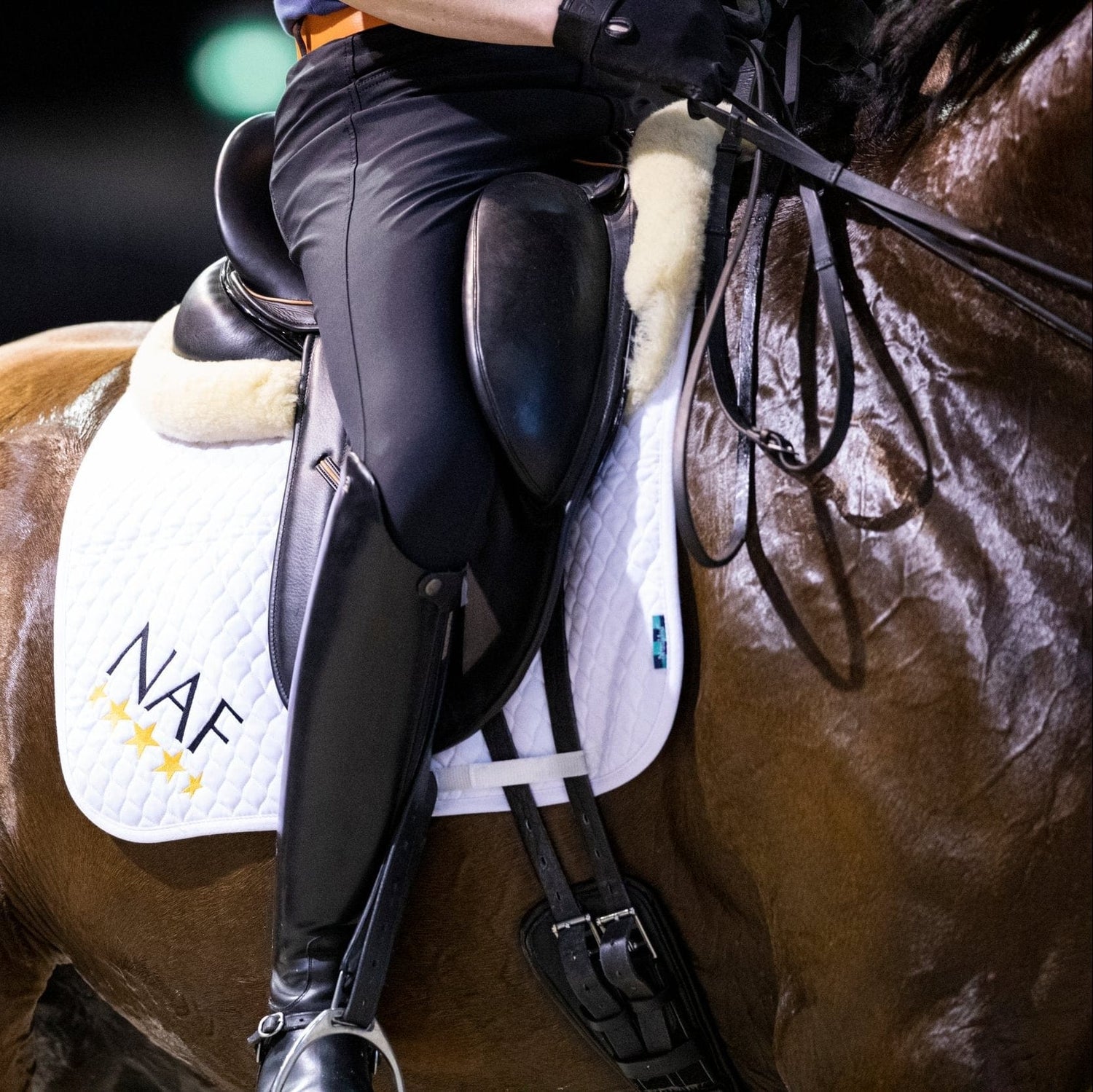When and how to replace those essential sweat losses for maximum recovery
Sweat losses are a critical aspect of equine nutrition. Often thought of as only for elite performers, replacing sweat losses is vital for all.
Sweat
Sweat is a clear, salty solution that horses – like us – use to help regulate body temperature, particularly when exercising, through evaporation from the skin. Horses have a high sweat rate, and use sweating as the primary, and most effective, method of thermoregulation. Sweat is lost via glands across the body which secrete the fluid via hair follicles, and the horse has around 800 glands per square centimetre!
Sweat consists primarily of water and the body ions, or electrolytes. However, horse sweat also contains proteins including latherin, which causes the white foam we see on heavily sweating horses.
Horses have particularly concentrated sweat, it being described as hypertonic to plasma, meaning it contains more electrolytes and is at greater osmotic pressure than body fluid, or plasma, would be. This is particularly true in heavily sweating horses, as the higher the level of sweat the more concentrated it becomes, until proportionally more salt is lost than water.
Electrolytes
Electrolytes are body salts, or ions, responsible for many key functions within the body. They are crucial to the balance of the acid-base status in the body, which ensures the right ratio of acidic to basic (alkaline) compounds in solution is maintained. This equilibrium is vital for the body to function normally. The most important to the horse are Sodium, Potassium and Chloride; though Magnesium and Calcium also have roles to play. Sodium and Chloride are typically provided together, being the salt we are all familiar with (NaCl). Over half of the body’s sodium is in the bones. Potassium is mainly concentrated in the muscles, while the chloride is more evenly distributed through the body.
Once sweating starts, large amounts of electrolytes can be lost in a relatively short amount of time. Many factors will influence how much sweat is lost including temperature, humidity and exercise rate. Rates of up to 20 litres of fluid lost from endurance horses in hot weather racing are recorded, which relates to around 4-6% of total body weight.
Loss of electrolytes and water in sweat has a measurable effect on that vital acid-base balance discussed, with prolonged moderate intensity exercise typically causing mild alkalosis through chloride loss. Early signs of dehydration (see Figure 1) include a drop in performance and concentration, whilst long-term can lead to fatigue, weakness and has been associated with issues such as thumps (Diaphragmatic flutter) and tying-up (Exertional rhabdomyolysis).
Signs of Dehydration
- Muscle weakness
- Loss of skin elasticity
- Increased heart rate
- Increased respiratory rate
- Increased rectal / core temperature
- Impaired mental function
- Muscle fasciculations (twitching)
How and When to Feed
Sweat losses need to be replaced whenever the horse has sweated, generally when they are working above a very light work regime. Horses are very good at dissipating sweat, and it is easy for sweat losses to go relatively unnoticed, as the horse will certainly not always be ‘dripping’.
What should we look for?
There are several different ways of trying to calculate sweat losses, but nearly all have their own limitations and are not necessarily practical for us, as horse owners. Research in Germany has aimed to design a ‘Sweat Score’ with easily recognisable signs that owners can relate to. That work also used body weight loss to establish actual losses, so we can see that even a slightly damp saddle cloth relates to sweat losses of up to 4L in a typical Warmblood (Table 1).
Table 1: Sweat Scores with Observed Signs
(600kg Warmblood, fit for light to medium work)
| Sweat Score | Observed Signs | Sweat Loss (L) |
| 1 | Under saddle partly dry, but partly dark, sticky and moist. Sticky throat area. Flanks darker than normal. |
1.6 - 4.0 |
| 2 | Wet under saddle and on throat. Possible small white areas at tack edges through foaming. Sweat obvious where reins touch throat, and inner hind legs. |
4.0 - 7.2 |
| 3 | Bridle leaves clear wet mark on head, often with foam. Saddle and throat areas consistently wet. Flanks clearly wet. |
7.2 - 9.3 |
| 4 | Throat and flanks completely wet. Moist, dark wrinkles above the eyes. Possible white between inner hind legs from pronounced foaming. |
9.3 - 11.8 |
| 5 | Horses additionally dripping fluid above the eyes and under the belly. | 11.8 - 18.0 |
Adapted from Zeyner et al, 2014
Next time you untack your horse feel the saddle cloth, or the skin under the saddle, Whether hacking, schooling or competing, if you are feeling dampness under the saddle, or seeing some damp areas around the throat and under the reins, then it is time to think about replacing those electrolytes.
It is important to remember that as well as the electrolytes themselves the sweat losses include significant amounts of water. It is imperative that water is replaced alongside the electrolytes, as failure to do so can negatively impact uptake of both water and electrolytes across the gut wall.
Just because you feed electrolytes, does not mean they get into the horse.
Further, use of super-concentrated electrolytes, such as pastes, can act as an irritant in the stomach and has been found to cause gastric ulcers (Holbrook et al 2005). The best way to avoid that risk is to add electrolytes to a really wet feed – something like well soaked sugar beet – or to acclimatise the horse to taking electrolytes from drinking water. A wet, fibrous feed is ideal, as the fibre also helps support the gut’s role as a fluid reservoir for hydration. Either way, ensure clean, fresh water is also always available.
Electrolytes should be given whenever the horse has worked, and when observed signs show that sweating has taken place (Table 1). Not just for competing horses, remember mares during foaling and stallions during covering will both also require electrolytes. Lastly, as travel always results in sweating, if the horse has travelled then electrolytes are recommended.
Research shows pre-loading is advised, i.e. feeding electrolytes one hour before travelling. This should be sufficient to see them through the competition. However, if that journey is more than two hours long, rest breaks should be provided and electrolytes fed (Lindinger 2022, Waller & Lindiger 2023). Post-competition electrolyte supplementation is also important to aid recovery.
Conclusion
As horse owners and carers, it is our responsibility to know the importance of electrolytes to working horses at all levels, and know when and how to replace those essential elements with safe and appropriate supplementation.
Selected References
- Alshut F, Martinsson G, Venner M & Vervuert I (2022) Salt supplementation in exercising horses: any harmful effects on gastric mucosa? Proceedings of EWEN, Equine Nutrition to Industry Event. Cirencester Aug 22.
- Holbrook T.C, Simmons R.D, Payton M.E & MacAllister C.G (2005) Effect of repeated oral administration of hypertonic electrolyte solution on equine gastric mucosa. Equine Vet Jn. 37, 501-504
- Lindinger M.I (2022) Oral electrolyte and water supplementation in horses. Vet Sci. 9, 626
- Waller A.P & Lindiger M.I (2023) Tracing acid-base variables in exercising horses: effects of pre-loading oral electrolytes. Animals. 13, 73
- Zeyner A, Romanowski K, Vernunft A, Harris P & Kienzle E (2014) Scoring of sweat losses in exercised horses – a pilot study. J. Anim Physiol Anim Nutr (Berl). Apr 98(2) 246-50
Written by: Kate Hore, Head Nutritionist. RNutr (Animal), R.Anim.Technol (Cert), BSc(Hons). – Find out more about Kate and out Technical Team HERE.



